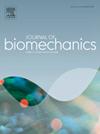Age-related changes in gait coordination are focused on the step-to-step transition
IF 2.4
3区 医学
Q3 BIOPHYSICS
引用次数: 0
Abstract
This study examined age-related changes in lower extremity coordination during gait using a unique gait phase normalization method, allowing time-continuous analysis while preserving phase-specific differences. Ten young and ten older healthy adults walked on an instrumented treadmill at their Preferred Walking Speed (PWS). Continuous Relative Phase (CRP) was used to assess intralimb and interlimb coordination and its variability across the gait cycle. Results showed that while older adults maintained largely similar coordination patterns to younger adults, significant differences emerged during transitions from double to single support. Specifically, older adults demonstrated altered hip-knee and interlimb knee coordination, driven by an earlier phase transition in knee phase angle during loading response and a delayed transition in hip phase angle during pre-swing. These alterations were accompanied by increased variability in interlimb hip coordination, particularly during critical gait transitions. Our findings suggest that age-related coordination changes are subtle and primarily affect step-to-step transitions. These changes may contribute to previously reported decreases in PWS, shorter step length, and increased metabolic cost in older adults. Future research should examine the relationship between these coordination changes and the age-related decline in PWS and increased metabolic cost of walking, as both are key consequences of altered step-to-step transitions.
与年龄相关的步态协调变化集中在一步到一步的过渡上
本研究使用一种独特的步态相位归一化方法检查步态中下肢协调的年龄相关变化,允许时间连续分析,同时保留相位特异性差异。10名年轻和10名年长的健康成年人以他们的首选步行速度(PWS)在带器械的跑步机上行走。连续相对相(CRP)用于评估肢体内和肢体间协调及其在整个步态周期中的变异性。结果表明,虽然老年人与年轻人保持着基本相似的协调模式,但在从双人支持到单人支持的转变过程中出现了显著差异。具体来说,老年人表现出髋-膝关节和肢间膝关节协调的改变,这是由于加载反应时膝关节相角的早期相变和预摆时髋关节相角的延迟相变所驱动的。这些改变伴随着肢间髋关节协调变异性的增加,特别是在关键的步态转变期间。我们的研究结果表明,与年龄相关的协调变化是微妙的,主要影响步到步的转变。这些变化可能有助于先前报道的老年人PWS下降、步长缩短和代谢成本增加。未来的研究应该检查这些协调变化与年龄相关的PWS下降和步行代谢成本增加之间的关系,因为这两者都是步到步转换改变的关键后果。
本文章由计算机程序翻译,如有差异,请以英文原文为准。
求助全文
约1分钟内获得全文
求助全文
来源期刊

Journal of biomechanics
生物-工程:生物医学
CiteScore
5.10
自引率
4.20%
发文量
345
审稿时长
1 months
期刊介绍:
The Journal of Biomechanics publishes reports of original and substantial findings using the principles of mechanics to explore biological problems. Analytical, as well as experimental papers may be submitted, and the journal accepts original articles, surveys and perspective articles (usually by Editorial invitation only), book reviews and letters to the Editor. The criteria for acceptance of manuscripts include excellence, novelty, significance, clarity, conciseness and interest to the readership.
Papers published in the journal may cover a wide range of topics in biomechanics, including, but not limited to:
-Fundamental Topics - Biomechanics of the musculoskeletal, cardiovascular, and respiratory systems, mechanics of hard and soft tissues, biofluid mechanics, mechanics of prostheses and implant-tissue interfaces, mechanics of cells.
-Cardiovascular and Respiratory Biomechanics - Mechanics of blood-flow, air-flow, mechanics of the soft tissues, flow-tissue or flow-prosthesis interactions.
-Cell Biomechanics - Biomechanic analyses of cells, membranes and sub-cellular structures; the relationship of the mechanical environment to cell and tissue response.
-Dental Biomechanics - Design and analysis of dental tissues and prostheses, mechanics of chewing.
-Functional Tissue Engineering - The role of biomechanical factors in engineered tissue replacements and regenerative medicine.
-Injury Biomechanics - Mechanics of impact and trauma, dynamics of man-machine interaction.
-Molecular Biomechanics - Mechanical analyses of biomolecules.
-Orthopedic Biomechanics - Mechanics of fracture and fracture fixation, mechanics of implants and implant fixation, mechanics of bones and joints, wear of natural and artificial joints.
-Rehabilitation Biomechanics - Analyses of gait, mechanics of prosthetics and orthotics.
-Sports Biomechanics - Mechanical analyses of sports performance.
 求助内容:
求助内容: 应助结果提醒方式:
应助结果提醒方式:


